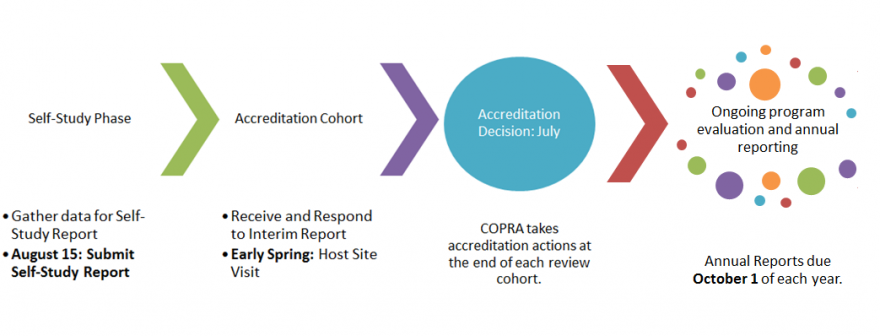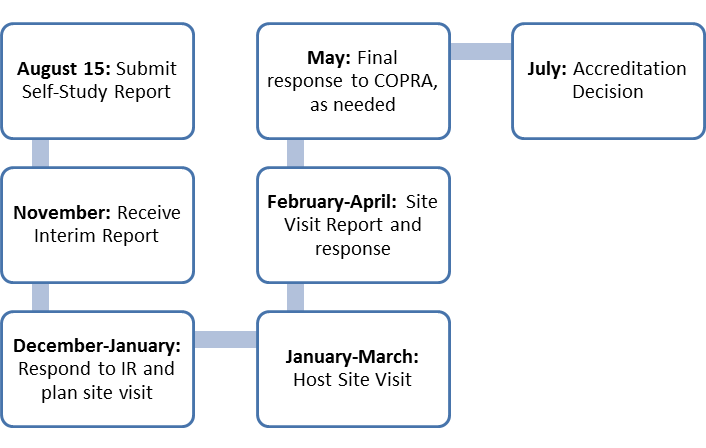Accreditation Cycle
The accreditation review process formally begins with completion of the Self-Study Report in the NASPAA Data Center. Eligibility-reviewed programs seeking their first accreditation, and programs seeking reaccreditation, must submit a Self-Study Report by August 15 to proceed through the review process.
The accreditation process begins with programs completing the Self-Study Report, using the Self-Study Instructions as a guide, during the Self-Study Year. The Self-Study Year, defined as the academic year immediately preceding the Self-Study Report submission (self-defined as either including the summer term before the academic year or immediately preceding the submission), signals the specific student and faculty data to be provided. Programs must submit the Self-Study Report in the Data Center by August 15. Accompanying the Self-Study Report, programs must also remit the accreditation fee and submit the Accreditation Application, signed by both the NASPAA principal representative and university provost, which verifies university support of the program. The Self-Study Report should be completed in English.
With the submission of the Self-Study Report, programs begin a conversation with COPRA about ongoing programmatic improvement. The Commission thoroughly reviews each Report and responds to the program, individually, with questions or requests for more information, as well as a recommendation for proceeding to Site Visit, in the Interim Report. The Interim Report identifies the program’s COPRA liaison and gives the Commission the opportunity to not only communicate with the program, but also provide direction to the Site Visit Team, who will visit the program in the upcoming Spring.
While programs formulate a Response to the Interim Report, they work with NASPAA staff to finalize a Site Visit Team, arranging the logistics of the visit directly with the Team. Site Visits allow COPRA to verify and clarify details about the program through the Site Visit Team, and are hosted throughout the Spring of the cohort year. Within 30 days of the Site Visit, the Site Visit Team drafts its Site Visit Report and shares it with the program. The program has a two-week window to suggest factual edits or point out inconsistencies, prior to the finalizing of the Report.
Once the Report is final and before COPRA meets in June, the program has one last chance to communicate with the Commission — a Final Response to the Site Visit Report, updating the Commission on program progress since the Self-Study or Site Visit, responding to the Site Visit Report, and/or uploading any supplementary documents COPRA has requested. COPRA renders a final accreditation decision in July. The Decision Letter (see a sample) is uploaded to the NASPAA Data Center, as well as mailed to both the program and university provost. The letter may also include a monitoring report, which notes Standards where COPRA expects the program to continue the conversation and report annual progress. COPRA releases its Roster of Accredited Programs, as well as its annual Accreditation Action Statement September 1 of each year.
Once a program is accredited, it is required to submit an Annual Accreditation Maintenance Report (also called AMR or AR) each fall. For more on the annual reporting requirement, please see the Annual Maintenance Report page.
Have more questions? See our Frequently Asked Questions.
Ready to start your Self-Study Report? Click here for the NASPAA Data Center or first browse the Technical Instructions for Self-Study Report. Want to draft your Self-Study Report before transferring the information to the NASPAA Data Center? Use these Word Instructions.


